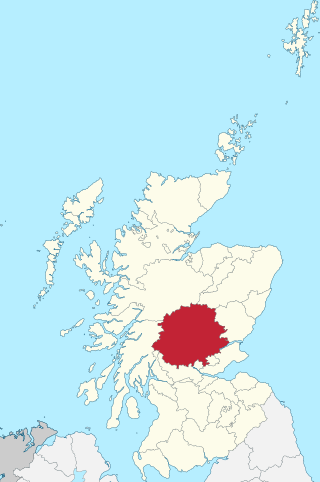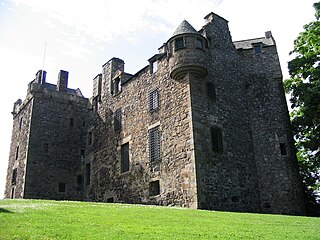Related Research Articles

Perthshire, officially the County of Perth, is a historic county and registration county in central Scotland. Geographically it extends from Strathmore in the east, to the Pass of Drumochter in the north, Rannoch Moor and Ben Lui in the west, and Aberfoyle in the south; it borders the counties of Inverness-shire and Aberdeenshire to the north, Angus to the east, Fife, Kinross-shire, Clackmannanshire, Stirlingshire and Dunbartonshire to the south and Argyllshire to the west.

Perth is a centrally located Scottish city, on the banks of the River Tay. It is the administrative centre of Perth and Kinross council area and is the historic county town of Perthshire. It had a population of about 47,430 in 2018.

Perth and Kinross is one of the 32 council areas of Scotland, and a lieutenancy area. It is bordered by Highland and Aberdeenshire to the north, Angus, Dundee, and Fife to the east, Clackmannanshire to the south, and Stirling and Argyll and Bute to the west.

Blair Atholl is a village in Perthshire, Scotland, built about the confluence of the Rivers Tilt and Garry in one of the few areas of flat land in the midst of the Grampian Mountains. The Gaelic place-name Blair, from blàr, 'field, plain', refers to this location. Atholl, which means 'new Ireland', from the archaic Ath Fhodla is the name of the surrounding district.

Errol is a village in Perth and Kinross, Scotland, about halfway between Dundee and Perth. It is one of the principal settlements of the Carse of Gowrie. It lies just north of the River Tay. The 2016 population of Errol was estimated to be 1,500 persons, compared to 1,070 in the 2001 Census and 1,311 in the 2011 Census.

Bridge of Earn is a small town in Perthshire, Scotland. Often referred to simply as 'The Brig'. The village grew up on the south bank of an important crossing of the River Earn, whose sandstone bridge existed from at least the early 14th century, when it is known to have been repaired by order of King Robert I of Scotland (1306–1329). Substantial remains of the medieval bridge survived into the 1970s, when almost all the stonework was demolished, for (allegedly) being in a dangerously ruinous condition. This ancient bridge was a major landmark on the road between Edinburgh and Perth for several centuries. The village's oldest houses are to be found lining the road leading south from the site of the demolished bridge. Among them are some with 18th-century datestones.

Elcho Castle is located close to the south bank of the River Tay approximately four miles south-east of Perth, Scotland, in the region of Perth and Kinross. It was maintained by Clan Wemyss from its construction around 1560 until it was put into the care of the Secretary of State for Scotland in the early 20th century, though was not occupied for the entire time. In around 1830 it was re-roofed and a nearby cottage constructed. The castle has been a scheduled monument since 1920 on the grounds of being "a particularly fine example of a Medieval tower-house", and the cottage became a listed building in 1971 in recognition of its national importance. The castle is unusual in that it has both en suite guest accommodation like a mansion, but also a large number of gun loops.

Dull is a village in Perth and Kinross, Scotland. It is paired with Boring, Oregon. Bland, New South Wales, Australia, is also a member of the League of Extraordinary Communities established by Boring and Dull in 2013.

Forgandenny is a small village in Perth and Kinross, Scotland, located four miles south of Perth. Perth is a 20-minute bus ride from Forgandenny, and there is a regular Stagecoach service. It is 45 minutes from Edinburgh and one hour from Glasgow. There is a daily train service from Perth to London King's Cross.

Kinnoull Hill is a hill located partly in Perth and partly in Kinfauns, Perth and Kinross, Scotland. It shares its name with the nearby Kinnoull parish.

Kilspindie is a village in Perth and Kinross, Scotland. It is situated on the Kilspindie burn, approximately 2+3⁄4 miles northwest of Errol, 12 miles west of Dundee centre and 6+1⁄2 miles east of Perth. The village has an area of 6,500 acres of which 3,500 acres are arable land and 200 acres are woodland, the local geology is mostly whinstone, amygdule and trap. Records show there was a chapel in the village since at least 1214 though the current church, the Kilspindie and Rait Parish Church, was built in 1670 and refurbished in 1938. The village previously housed the Kilspindie Castle which was demolished before 1670.
Perth is a city and former royal burgh in central Scotland. There has been a settlement at Perth since prehistoric times. Finds in and around Perth show that it was occupied by the Mesolithic hunter-gatherers who arrived in the area more than 8,000 years ago. Nearby Neolithic standing stones and circles followed the introduction of farming from about 4000 BC, and a remarkably well preserved Bronze Age log boat dated to around 1000 BC was found in the mudflats of the River Tay at Carpow to the east of Perth. Carpow was also the site of a Roman legionary fortress.

Caputh is a parish and village in Perth and Kinross, Scotland. It lies on the A984 Coupar Angus-to-Dunkeld road, about 6 miles southeast of Dunkeld and 8 miles west of Coupar Angus.

Collace is a parish in Perthshire, Scotland, 8 miles northeast of Perth, in the Carse of Gowrie district. The parish boundary includes the neighbouring villages of Kinrossie and Saucher.

Killiechassie is a country estate and house near Weem, about one mile northeast of Aberfeldy, in Perth and Kinross, Scotland. The estate lies on the banks of the River Tay in some 12 acres, about 74 miles north of Edinburgh. It was owned by the Douglas family in the latter part of the 19th century, and a new house was erected in 1865. A dovecote by the house was listed as Grade B on 9 June 1981. The house was purchased by author J.K. Rowling in 2001.

Bridgend is a village near Perth, Scotland, approximately 0.25 miles (0.40 km) east of the city centre, on the eastern banks of the River Tay. It is in Kinnoull parish. A settlement has existed here since at least the 16th century.

St John's Kirk is a church in the Scottish city of Perth, Perth and Kinross. Of Church of Scotland denomination, it is located in St John's Place, just southeast of the city centre. It stands on the former site of a church dating to 1126. Today's structure, built around 1448, is a Category A listed building. The church is most noted for being the site of John Knox's 1559 sermon against idolatry, which began the Scottish Reformation.
William Macdonald Mackenzie was a Scottish architect, prominent in the first half of the 19th century. He designed several notable buildings in Scotland, mostly manses and church buildings.

Gowrie House was a building in the centre of Perth, Scotland, which existed in the 16th and 17th centuries. An earlier house on the site was standing in 1518, built or occupied by Elizabeth Gray, Countess of Huntly and the second wife of Alexander Gordon, 3rd Earl of Huntly. A document of 1552 mentions the great lodging that she had built in the Speygate of Perth. Latterly, the rebuilt and extended house was the home of George Hay, 1st Earl of Kinnoull (1570–1634), amongst others.

Leslie's directory for Perth and Kinross was an annual book of post office directories for Perth and Kinross, published between 1885 and 1939. It included registers of proprietors, gentry, factors, farmers, merchants, public officials and clergy "in the county and vicinity of Perth".
References
- Specific
- General
- Groome, Francis H (1882–1885). "Parish of Perth". Ordnance Gazetteer of Scotland: A Survey of Scottish Topography, Statistical, Biographical and Historical.
- Cowan, Samuel (1904). "Chapter III". Perth, the Ancient Capital of Scotland. Electric Scotland.
- Lewis, Samuel (1846). "Perth". A Topographical Dictionary of Scotland. British History Online.
- Anderson, William (1863). "Ross". The Scottish Nation. Electric Scotland.
- https://scotlandsplaces.gov.uk/digital-volumes/ordnance-survey-name-books/perthshire-os-name-books-1859-1862/perthshire-volume-66/214